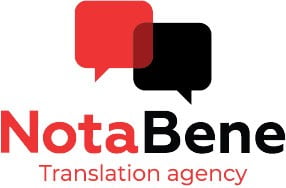Order translation from Hebrew or into Hebrew at NotaBene Agency in Warsaw and Gdansk!
NotaBene Translation Agency is an experienced supplier of translation from Hebrew into Polish and vice versa for any documents or texts.
What types of texts does NotaBene Translation Agency work with?
– Technical translation from Hebrew — we translate any texts in electronics, aviation and shipbuilding, agriculture, industry, oil and chemistry, etc. For this purpose, we pick translators who understand the specific nature of a given industry.
– IT translation from Hebrew for the localization of applications, games, software and websites.
– Medical translation from Hebrew — books, manuals, articles in specialized printed and online publications, clinical records, correspondence with medical institutions, transcriptions and translations of test results, instructions for medicines and many other types of texts. This kind of translation requires flawless knowledge of medical terminology and focus on detail to rule out ambiguity, because the result can affect the health or life of many people.
– Legal translation from Hebrew: statutes, registration deeds, articles of incorporation, contracts, powers of attorney, court records and many other similar documents.
– Financial translation from Hebrew: this type of translation includes balance sheets, tax returns, payment invoices, waybills, tender documents, etc.
– Literary or fiction translation from Hebrew of fiction, marketing and advertising materials. Unlike the previous types of translation, in this case there is more room for a translator’s creativity, because there is no need for “word for word” translation. The most important thing is that the translated material produces the same impact as the original, while an excellent translation may even make it better.
Please note that the translation mentioned is certified by an agency seal only. If you need sworn translation, kindly notify your manager in advance. Sworn translation is possible only for certain languages.
How to have a translation from Hebrew into English, Polish, Russian, Belarusian or Ukrainian?
First of all, you need to order it. To do so, send your source text and specify your requirements for the translation from Hebrew. A customer service specialist at the Nota Bene Translation Agency will prepare a ToR based on the specific features of the order. If the project involves more than one job, a unique glossary is created to ensure the consistency and proper use of terminology.
An entire team of several professionals normally make the translation from Hebrew: a translator, proofreader, editor, quality controller, layout designer and manager who will be available during working hours. In order to rule out human errors, the translation agency uses modern services to check punctuation, idioms, numerical expressions, and formulas. The material is also reviewed by the chief editor.
Confidentiality of translated data is ensured by a special NDA, whenever a customer wishes to have one. Documents can be delivered to any country.
We very rarely apply additional fees for “urgency” or “specialized subjects”, so you can be sure that the price will not rise when the project is delivered. It is true that in rare cases, such as “we need to have it yesterday” instances, and when a customer is willing to pay a higher rate for the team to work outside normal working hours, at night or on weekends, the fee might be increased, but this is always negotiated with the customer in advance.
Interesting facts about Hebrew
One of the oldest languages in the world, Hebrew has an unusual history. Having survived for centuries as the language of the Bible, it experienced its second birth only recently, about a hundred years ago. Speakers of Hebrew as a native language is a relatively new phenomenon in modern history, and there are more and more of them every year.
1. Today Hebrew is spoken by about 9 million people worldwide living in Israel and numerous Jewish communities all over the world.
2. The first written examples of Hebrew date back to the 10th century BC. And it became a definitive language around 3000 B.C. when the tribes of Israel united into a homogeneous group.
3 The main reason for its survival, as a spoken Hebrew language superseded other languages between 200 AD and 400 AD, was that it remained the language of Judaism’s holy texts. The study of the Torah by many generations has enabled Hebrew to survive the centuries. It has also remained the language of literature, science and publications on various, usually lofty topics, and Hebrew has been the lingua franca of Jews throughout the world. A kind of analogue of Latin.
4. Hebrew was superseded by several languages, but Aramaic, which was very close to Hebrew, played a significant role in this; most ancient Jews knew and were fluent in both languages. Under the influence of Aramaic the writing also changed, there appeared a square script, the so called Jewish square script, which is a standard script today.
5. There are two versions of Hebrew, an ancient form and a modern version, which is the official language of Israel. Hebrew, which had almost lost its significance as the language of the Torah and of religious ceremonies, began to grow in popularity towards the end of the 19th century, and was given new life during the creation of Israel as a separate state. It was selected and artificially recreated in its modern form. Many words, for example technical, had to be invented from scratch, or old concepts modernised.
6. The regulation of all linguistic matters concerning the Hebrew language is handled by the official institution, the Academy of the Hebrew Language. This organization functions in Israel and one of its functions is to approve the form of new words.
7. A huge role in the establishment of modern Hebrew was played by Eliezer Ben-Yehuda. He initiated the publication of the Complete Dictionary of Ancient and Modern Hebrew, founded the Hebrew Language Committee, promoted the revival of Hebrew in every possible way and did a lot of linguistic work. As Hebrew was the primary spoken language in Ben-Yehuda’s family, his son was the first person in modern history to use it as a mother tongue. After all, even the first teachers of Hebrew knew it only as a second language, the first for most of them was Yiddish.
8. Traces of ancient Hebrew have survived in many European languages, particularly in the form of popular names. Jacob, Joseph, Mary, Adam, Daniel and other names are found in different variations in almost all languages. We are also familiar with Hebrew words like “amen”, “hallelujah”, “messiah”, etc.
9. The peculiarity of written Hebrew is that words are written with single consonants, vowels can be written with special signs, for example in children’s books to facilitate understanding. It is also unusual for us to write and read from right to left.
10. There is a theory that the Lilliputian language in Jonathan Swift’s Gulliver’s Travels is not just a set of meaningless sounds, as previously thought, but is a slightly modified Hebrew phrase. That is the conclusion reached by Irving Rothman, a professor of English literature at the University of Houston. The phrase “Hekinah degul”, which the midgets shout when they bind Gulliver, for example, the professor translates as follows: “degul” in Hebrew is “flag”, and “hikinah” is a verb meaning “to give, to transmit”. And thus the Lilliputians call upon Gulliver to surrender to their flag.
We have been in business for over 20 years and during that time we have learned to work well. Trust us with your translation from Hebrew and get a great result at a reasonable price!








